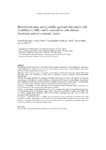Mostrar o rexistro simple do ítem
Homebound Status Among Middle-Aged and Older Adults With Disabilities in ADLs and Its Associations With Clinical, Functional, and Environmental Factors
| dc.contributor.author | De-Rosende, Iván | |
| dc.contributor.author | Santos-del-Riego, Sergio | |
| dc.contributor.author | Muñiz, Javier | |
| dc.date.accessioned | 2018-01-18T09:25:54Z | |
| dc.date.available | 2018-01-18T09:25:54Z | |
| dc.date.issued | 2016-06-29 | |
| dc.identifier.citation | De-Rosende Celeiro I, Santos-del-Riego S, Muñiz García J. Homebound status among middle-aged and older adults with disabilities in ADLs and its associations with clinical, functional, and environmental factors. Disabil Health J. 2017;10(1):145-151 | es_ES |
| dc.identifier.issn | 1936-6574 | |
| dc.identifier.issn | 1876-7583 | |
| dc.identifier.uri | http://hdl.handle.net/2183/20007 | |
| dc.description | Brief Report | es_ES |
| dc.description.abstract | [Abstract] Background. Homebound status is associated with poor health, comorbidity, and mortality and represents a major challenge for health systems. However, its prevalence among people with disabilities in the basic activities of daily living (ADLs) is unknown. Objectives. The objectives were to: (1) examine the prevalence of the homebound status among middle-aged and older adults with disabilities in ADLs, and (2) identify its clinical, functional, and environmental determinants. Methods. This study included 221 community-dwelling subjects, aged ≥50 years, who applied for long-term care services at the Office for Legal Certification of Long-term Care Need of Coruña (Spain). Each subject had a disability in ADLs and was interviewed by a trained examiner in the subject's home. The participants were considered homebound if they remained inside their home during the previous week. Measures. Demographic, clinical, functional, and environmental factors. Multiple logistic regression was used to determine the factors associated with homebound status. Results. The prevalence of homebound status was 39.8%. A multivariate analysis revealed that the presence of architectural barriers at the home entrance (stairs [OR: 6.67, p < 0.001] or a heavy door [OR: 2.83, p = 0.023]), walking ability limitations (OR: 3.26, p = 0.006), and higher age (OR: 1.05, p = 0.04) were associated with homebound status. Conclusions. Homebound status is a highly prevalent problem among middle-aged and older adults with disabilities in ADLs. Architectural factors in the home and walking ability limitations seem to be important predictors, suggesting that health care interventions should target home adaptations and mobility skills as a means to preventing or decreasing homebound status. | es_ES |
| dc.language.iso | eng | es_ES |
| dc.publisher | Elsevier | es_ES |
| dc.relation.uri | http://dx.doi.org/10.1016/j.dhjo.2016.06.006 | es_ES |
| dc.rights | Atribución-NoComercial-SinDerivadas 3.0 España | es_ES |
| dc.rights.uri | http://creativecommons.org/licenses/by-nc-nd/3.0/es/ | * |
| dc.subject | Accesibility | es_ES |
| dc.subject | Functional disability | es_ES |
| dc.subject | Homebound status | es_ES |
| dc.subject | Mobility | es_ES |
| dc.subject | Prevalence | es_ES |
| dc.title | Homebound Status Among Middle-Aged and Older Adults With Disabilities in ADLs and Its Associations With Clinical, Functional, and Environmental Factors | es_ES |
| dc.type | info:eu-repo/semantics/article | es_ES |
| dc.rights.access | info:eu-repo/semantics/openAccess | es_ES |
| UDC.journalTitle | Disability and Health Journal | es_ES |
| UDC.volume | 10 | es_ES |
| UDC.issue | 1 | es_ES |
| UDC.startPage | 145 | es_ES |
| UDC.endPage | 151 | es_ES |
Ficheiros no ítem
Este ítem aparece na(s) seguinte(s) colección(s)
-
UI-INTEGRA_SAUDE - Artigos [64]
-
INIBIC-ECAPE - Artigos [31]
-
UI-TOINF - Artigos [18]
-
GI- GRINCAR - Artigos [219]






